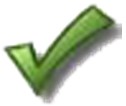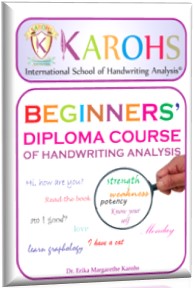What is the difference between the Comprehensive Course and the Master Course of Handwriting Analysis?
Today, there exist two major schools of graphology, namely the (1) Trait Stroke method and (2) the “Gestalt” approach. (“Gestalt” = German for “figure” or overall configuration).
(1) The Trait Stroke Method
Trait stroke method asserts that a specific stroke formation reveals a certain personality trait. For example, a looped d would be synonymous with “sensitiveness to criticism.”
France is irrefutably the cradle of trait stroke analysis and the Abbé Jean Hippolyte Michon (1809 – 1881) is the acknowledged father of graphology.
Michon devoted more than 40 years of his life to collecting thousands of handwriting samples and interpreted minute details or “elements”.
“With Michon,” says Robert Saudek, “the history of graphology really begins. All that had been done up to then consists only of interesting but by no means fundamental essays. To Michon graphology owes the discovery of the ‘signes fixes’ as graphic indicators in handwriting which go with certain qualities of character, and are therefore regarded as their symptoms.” (Robert Saudek: The Psychology of Handwriting,)
Although Michon depended on empirical observation alone, he was very successful. He was a shrewd observer of human nature and gained considerable experience through his lifelong studies in handwriting analysis. Saudek lauded that “Michon possessed an extraordinary gift of observation, an unusual memory, and an ardent interest in handwriting. He was a born empiricist.”
Michon coined the term “graphology” and even though his works were never translated into English, his “signes fixes” are the basis of American traits stroke courses up to the present day. The following is just a small part of his considerable list.
- initial hooks = acquisitiveness
- missing punctuation = inattention to details, carelessness
- slanted writing = emotionality, responsiveness
- curved strokes = humor
- rising lines = optimism
- left slant = reserve, withdrawal
- tied ovals = secretiveness
- Underlined name = self-reliance
After Michon’s death, his pupil J. Crėpieux-Jamin became the most important French graphologist. Saudek wrote that “he is unsurpassed as a practical worker, endowed with sharp observation, with extraordinary experience, and an innate talent for the judging of handwriting.”
In his book “L’Écriture et le Caractère” Crėpieux-Jamin demonstrated his theory of so-called “evaluated traits” or “resultants”. He theorized that only primary or basic traits show directly in handwriting whereas secondary or resulting characteristics must be evaluated through combinations of primary traits. A few examples of resultants were:
- Weak will + imagination = fear
- Evasiveness + selfishness = tendency to steal
- Egotism + Sarcasm + pride = malevolence
- Sensitive + weak will power + insecure = timidity
- Generosity + responsive + enthusiasm = empathy
- Regularity + self-control = patience
- Rhythm + quick comprehension + thread = cunning, sly
- Diplomacy + thready writing = obsequious
Because it was Crėpieux-Jamin who consolidated Michon’s principles into an organized system of handwriting analysis. He is generally considered the founder of the French school of graphology.
Contrary to the claims of certain graphology schools that they have developed their own system, the French school is still the primary basis of trait stroke graphology.
One school that has long claimed to have done major research in the field of trait stroke analysis is the International Graphoanalysis Society, with Milton Bunker the foremost researcher. Bunker claimed that he had personally discovered over 100 traits reflected in handwriting. From about 1912 until 1928, he allegedly empirically tested and verified each sign at least a thousand times before considering it valid.
In reality, according to Bob Backman (curator of the Handwriting Analysis Research Library), ”Bunker had borrowed, adapted and re-named the stroke principle” of at least “20 other authors, lifted almost verbatim, or re-worded.” This, “in some cases this led to the threat of legal action.” (Bob Backman, “Graphology in America,” 2001).
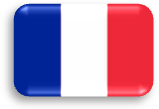 Today, the French model is the nearly universally accepted trait stroke method, perpetuated by sundry slightly re-worded or re-phrased but basically unchanged courses, published by various handwriting analysis “schools” and teachers.
Today, the French model is the nearly universally accepted trait stroke method, perpetuated by sundry slightly re-worded or re-phrased but basically unchanged courses, published by various handwriting analysis “schools” and teachers.
The Comprehensive Course is a “trait stroke” course. Other KAROHS courses based upon the trait stroke method are: 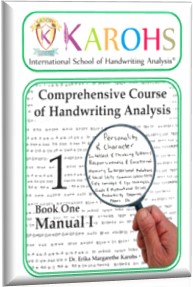
- Beginners Handwriting Analysis Diploma Course
- Evaluated Traits Course In Handwriting Analysis
(2) The “Gestalt” Method
 Around 1895, the “Gestalt” school of graphology was started in Germany. In contrast to the French method which analyzed individual letter forms, the German system stressed the importance of the writing movement itself. Around 1910, Dr. Ludwig Klages forced the final separation of the German school from the French and demanded a” scientific approach” to handwriting analysis. He developed his own system which became so popular that in 1929, the thirteenth printing of his book “Handschrift und Charakter” (“Handwriting and Character”) was used in German universities in preference to Sigmund Freud’s works.
Around 1895, the “Gestalt” school of graphology was started in Germany. In contrast to the French method which analyzed individual letter forms, the German system stressed the importance of the writing movement itself. Around 1910, Dr. Ludwig Klages forced the final separation of the German school from the French and demanded a” scientific approach” to handwriting analysis. He developed his own system which became so popular that in 1929, the thirteenth printing of his book “Handschrift und Charakter” (“Handwriting and Character”) was used in German universities in preference to Sigmund Freud’s works.
Eventually, Klages became so influential that he no longer allowed any graphology system but his own to exist in Germany.
The “method war” between both schools seems to continue unabated. In reality, both graphology schools are not nearly as incompatible as the proponents of each school like to believe. Trait stroke analysts use writing pressure or depth to determine the writer’s “depth of emotion.” The traits of “simplification” and” ostentation,” for instance, are determined through the element of form. The so-called trait of “rhythm” is discovered through writing movement, and narrowness and width of letters clearly belong to category of space.
While Gestalt graphologists even abhor the use of the word “trait stroke,” they often describe traits nevertheless. What Gestalt graphologists call “extreme smallness due to exaggeration of reality and fear of not being able to cope,” the trait stroke graphologist calls by the trait name “concentration” (used as a defense). Ironically, Gestalt textbooks often add footnotes, or endnotes, or special addenda with explanation for “special indicators.” For instance, (Müller-Enskat in their book “Graphologische Diagnostik”) list in the footnotes as “Besonderheiten” (peculiarities) “decreasing height toward end of words indicate diplomatic tendencies” and “pointed final strokes expose critical tendencies.” Trait stroke analysts simply call these two traits “diplomacy” and “sarcasm.”
A thoroughly knowledgeable graphologist can use either method and arrive at the same results, albeit travelling on different paths.
[wc_row][wc_column size=”one-fourth” position=”first”]
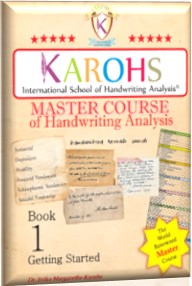
[/wc_column][wc_column size=”three-fourth” position=”last”]
The Master Course (before, named Step-By-Step System – SSS) of Handwriting Analysis is the only graphology course that integrates the trait stroke method with the following aspects of the Gestalt approach:
- vertical movement
- horizontal movement
- form and
- depth
The Master course is not alone in utilizing the above indicators. They are incorporated to a greater or lesser degree in other contemporary graphological schools.
The Master course, however, is the only course that combines both of these fundamental theories in one logical system.
[/wc_column][/wc_row]
How do KAROHS courses differ from other handwriting analysis courses?
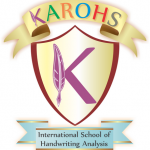 KAROHS Courses differ greatly from other handwriting analysis courses in that they are not simply compilations of the French (or the German) graphology school; instead, they also incorporate pioneering research by other remarkable graphologists, including some whose invaluable discoveries were little recognized, denigrated, or practically forgotten.
KAROHS Courses differ greatly from other handwriting analysis courses in that they are not simply compilations of the French (or the German) graphology school; instead, they also incorporate pioneering research by other remarkable graphologists, including some whose invaluable discoveries were little recognized, denigrated, or practically forgotten.
During more than 40 trips to Europe, including to countries behind the Iron curtain, Dr. Karohs collected research material, both in and out of print (some of it handwritten from personal estates). Dr. Karohs is proud to say that she possess graphology manuscripts that are not available anywhere else.
Two German graphologists whose work she became particularly absorbed with were Magdalene Ivanovic and Otto Junge. Because of the strong influence of Ludwig Klages and the unfortunate developments taking place during the Nazi regime in Germany both were, despite their groundbreaking work, little recognized, even shunned.
Ivanovic’s astounding discoveries were disparaged while Junge was harassed by Klages to a degree that his books were actually forbidden.
Ivanovic had an unequaled perception of uncommon graphic indicators. Among other indicators, she discovered the” airstroke” or “immaterial stroke.” These frictionless immaterial lines, she postulates, represent the intellectual. (Disconnected writing, according to Michon, is a sign of intuition.) “With the recognition of the airstroke, however, it is easily demonstrated that this is not disconnected writing, but only a writing of which parts are invisible. It is used when the writer’s fast mind believes that intellect can do a better job than physical activity.”( Frank Victor: A Personality Projection.)
Ivanovic discovered various forms of single and double curves, expanded curves, straight and diagonal strokes, and acute, right and obtuse angles. She also validated many other traits that are unknown to the majority of graphologists.
Ivanovic recorded her findings in several books. Her most famous work is “Die Gesetze der modernen Graphology” (The Laws of Modern Graphology), published in 1920. Ivanovic laments that the book was not even given “the honor of being discussed in the columns of a newspaper.” Most assuredly this was a great loss for the graphological community.
Otto Junge developed his graphology system “Rationale Graphology” (“Rational Graphology”) in Hamburg, Germany. His method was based on the assumption that in every individual there exist sets of opposing characteristics (a) and (b). Junge assigned quantitative values to either one of the characteristics, using 100 “Ausdruckstabellen” (expression tables) as a guide. The characteristic scoring the highest was deemed the significant one. His system is a fascinating one that gives deep insight into the personality.
Unfortunately, Junge’s theories never became popular in Germany. In 1936, publication of his book “Rationale Graphologie” was prevented by Ludwig Klages Klages who had managed to assume censorship of graphological works during the period of Hitler’s reign. With the “fortune telling law,” issued by the Berlin police chief in 1935, all graphology, except for Klages’ school, was prohibited. “This infamous decree,” laments Junge, “enabled the Klages’s camp to denounce 80% to 90% of all graphologists and to deprive them of their livelihood.”
Four years after the end of World War II, in 1949, Junge finally saw his book in print. The anticipated recognition, however, never came. The first issue of the “Zeitschrift fuer Graphologie und Charakterkunde” (“Journal for Graphology and Character Studies”) denounced Rational Graphology because “it (a) allegedly denied the significance of intuition in graphology and (b) tried to assess character through measurements and statistics alone.”
Some of Ivanovic’s and Junge’s discoveries, along with the findings or other notable graphologists have been included in ISHA courses. They are clearly identified as to their source.
Which graphology course should you choose?
![]() This is the question that I am being asked most frequently by prospective students.
This is the question that I am being asked most frequently by prospective students.
 If you want to become a thoroughly trained, knowledgeable professional graphologist I recommend starting with the Comprehensive Course of Handwriting Analysis.
If you want to become a thoroughly trained, knowledgeable professional graphologist I recommend starting with the Comprehensive Course of Handwriting Analysis.
Most of our graduates plan to become involved in some kind of personnel work upon graduation. Successful completion of the Comprehensive Course provides them with all the tools and in-depth knowledge needed to work as a professional analysts. It enables him and to perform analysis with absolute confidence.
Then, if you want to further your graphological education beyond this point, I recommend the Master course.
 The Master Course is unique in that it combines components of the trait stroke method with the Gestalt approach. Also, instead of looking at one handwriting indicator as standing for one personality trait, the Master method considers or evaluates ten handwriting components per personality trait. This results in an unbelievably accurate personality picture.
The Master Course is unique in that it combines components of the trait stroke method with the Gestalt approach. Also, instead of looking at one handwriting indicator as standing for one personality trait, the Master method considers or evaluates ten handwriting components per personality trait. This results in an unbelievably accurate personality picture.
Understandably, examining several handwriting indicators per trait takes longer than the pure trait stroke approach. On the other hand, this method allows the analyst to glean information about the personality that is not available by any other means.
On a practical level, the trait stroke method is usually used for personnel work, such as analyzing candidates for hiring. It provides all the necessary insight for clear and informative vocational and individual reports.
The Master method is ideal for analyzing candidates for top management positions, or real problem personalities, or cases where the greatest in-depth information about a writer is desired.
Both the Comprehensive course and the Master course can be started without prior knowledge in graphology. However, it is advisable to start with the Comprehensive Course. Many of the components taught in the Comprehensive course also appear in the Master course. It makes for an easier and smoother transition to begin with the Comprehensive Course.
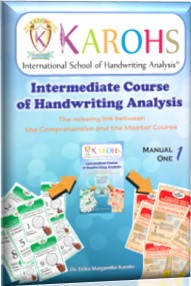 Students who desire an even smoother transition now have the opportunity to enroll in the newly published Intermediate Course of Handwriting Analysis. We consider this course the “bridge between the Comprehensive and the Master Course. It uses the integrated trait stroke/Gestalt approach but does not go into as much depth as the Master Course.
Students who desire an even smoother transition now have the opportunity to enroll in the newly published Intermediate Course of Handwriting Analysis. We consider this course the “bridge between the Comprehensive and the Master Course. It uses the integrated trait stroke/Gestalt approach but does not go into as much depth as the Master Course.
The Evaluated Traits course is a one-of-a-kind advanced trait stroke course that, at this time, in this format, students cannot find anywhere else. It is intended for students who want to progress beyond the Comprehensive Course but also want to stay entirely with the trait stroke method. 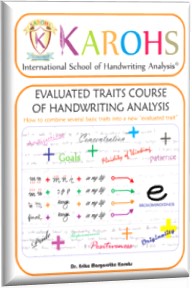
We know that you have many choices among so-called handwriting analysis schools and teachers. For that reason, we caution you to do your research very carefully. If someone promises you that you can learn handwriting analysis in ten minutes a day, it is time to look elsewhere. KAROHS has been in business since 1981 with a long list of satisfied graduates. Our study material is steadily upgraded in keeping with ongoing research. Our generous and prompt support is unmatched by any other handwriting analysis school.
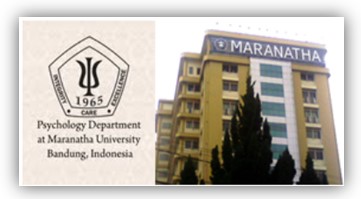 Most importantly, KAROHS courses have been chosen for inclusion into the curriculum of the Psychology Department at Maranatha University in Bandung, Indonesia. KAROHS courses were chosen exclusively because of the the educational and qualitative excellence of the KAROHS course material.
Most importantly, KAROHS courses have been chosen for inclusion into the curriculum of the Psychology Department at Maranatha University in Bandung, Indonesia. KAROHS courses were chosen exclusively because of the the educational and qualitative excellence of the KAROHS course material.
tag: Traits vs Gestalts in graphology
Quick Link:
FAQ (Frequently Asked Question) Price Information Registration Process : How to Enroll TESTIMONY : What Student Says about the Courses Back to COURSES Information
See detail courses programs (click the image below):
Copyright © 2014 the KAROHS International School of Handwriting Analysis®. All rights reserved.
No image or portion of this website may be copied or reproduced without written permission.


